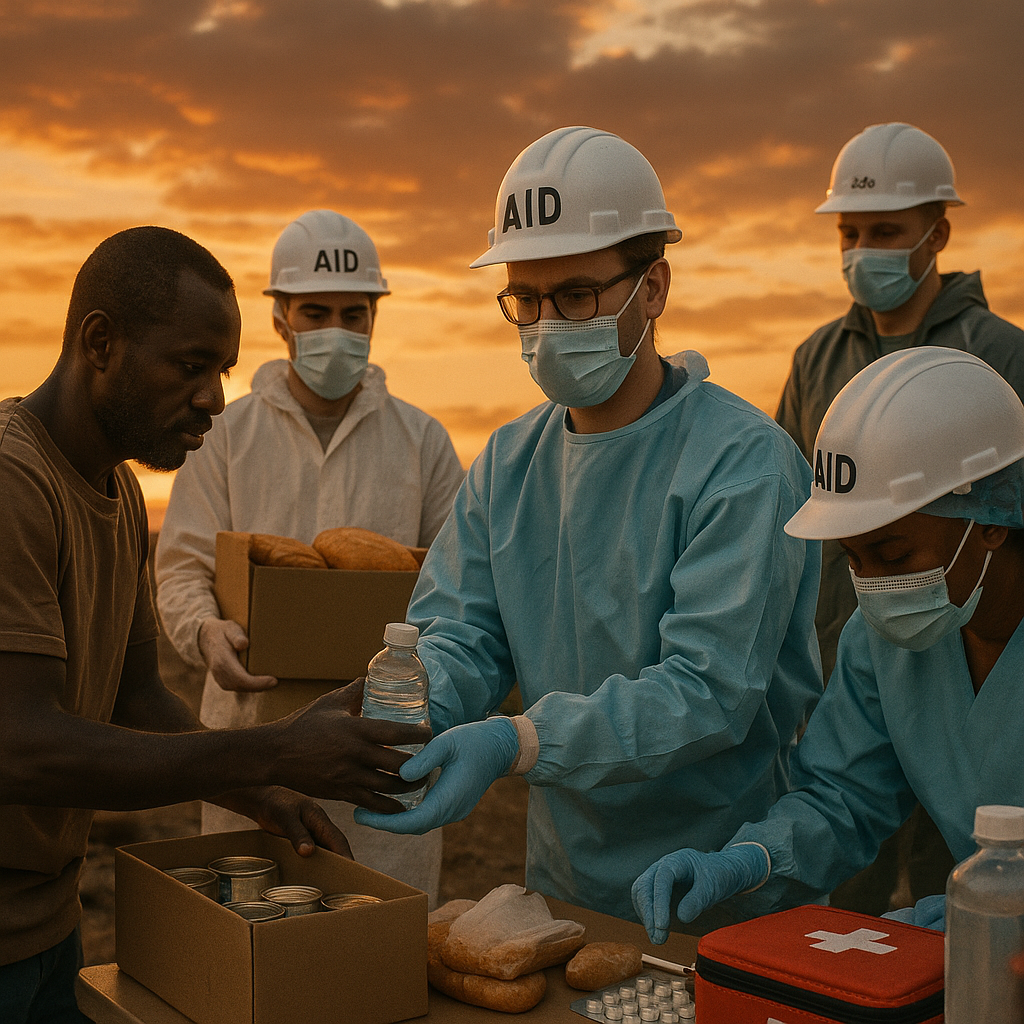World Humanitarian Day 2025: Global Solidarity in Crisis Response

World Humanitarian Day 2025: A Call for Global Solidarity and Local Empowerment
In a world grappling with escalating crises, the power of humanitarian aid stands as a beacon of hope. As we approach World Humanitarian Day (WHD) 2025, observed annually on August 19, the global community is called upon to reflect on the critical role of humanitarian workers and the pressing need for international cooperation. This year’s theme, “Strengthening Global Solidarity and Empowering Local Communities,” highlights a pivotal shift in humanitarian efforts, emphasizing the importance of both worldwide support and grassroots leadership in addressing complex emergencies.
The Evolution and Significance of World Humanitarian Day
Established in 2008 by the United Nations General Assembly, World Humanitarian Day commemorates the 2003 bombing of the UN headquarters in Baghdad, which claimed the lives of 22 aid workers, including Sergio Vieira de Mello, the UN Secretary-General’s Special Representative for Iraq. Since its first observance in 2009, WHD has served as a platform to honor humanitarian workers, advocate for their safety, and support vulnerable populations affected by armed conflict, natural disasters, and other crises.
The relevance of WHD has only grown over the years, as the global landscape of humanitarian needs continues to expand and evolve. In 2025, we face unprecedented challenges:
- Over 200 million people worldwide require humanitarian assistance and protection.
- The funding gap for humanitarian aid is staggering, with the 2024 Global Humanitarian Overview requiring $48.65 billion, yet only $12.26 billion received as of July 2024.
- Aid worker casualties remain alarmingly high, with 261 killed, 78 kidnapped, and 196 wounded in 2023 alone.
These statistics underscore the urgent need for global action and solidarity in addressing humanitarian crises.
The 2025 Theme: A Paradigm Shift in Humanitarian Action
The focus of WHD 2025 on “Strengthening Global Solidarity and Empowering Local Communities” represents a significant evolution in humanitarian thinking. This theme acknowledges the critical role of local actors in crisis response and recovery, moving away from traditional models of aid delivery that often prioritize external interventions.
Key aspects of this approach include:
- Localization of Aid: Empowering local humanitarian workers who understand the language, culture, and context of affected areas to lead response efforts.
- Community-Led Initiatives: Recognizing affected communities as active agents in their own recovery, rather than passive recipients of aid.
- Capacity Building: Investing in local organizations and individuals to enhance their ability to respond to crises effectively.
- Cultural Sensitivity: Ensuring that aid delivery is respectful of local customs, traditions, and social structures.
This shift towards local empowerment is not just a theoretical concept but a practical necessity. As Martin Griffiths, the UN Under-Secretary-General for Humanitarian Affairs, stated in a recent address, “The future of humanitarian action lies in the hands of those closest to the crises. Our role is to support and amplify their efforts, not to replace them.”
The Current Humanitarian Landscape: Challenges and Innovations
Rising Global Needs
The humanitarian sector faces unprecedented demands in 2025. Conflicts, climate-related disasters, and the lingering effects of the COVID-19 pandemic have created a perfect storm of humanitarian needs. The Sudan crisis exemplifies the complexity of current emergencies, with over 30 million people requiring aid and 5 million displaced abroad, necessitating a $10.28 billion humanitarian response.
Funding Shortfalls
Despite the increasing needs, funding for humanitarian aid is struggling to keep pace. Experts project that official development assistance may fall by 9%-17% in 2025, complicating aid delivery and forcing difficult prioritization decisions. This shortfall threatens critical services such as food distribution, healthcare, and shelter provision in crisis zones.
Innovations in Aid Delivery
In response to these challenges, the humanitarian sector is embracing innovation:
- Cash Assistance: There’s a growing trend towards multipurpose cash transfers, providing recipients with greater flexibility and dignity in meeting their needs.
- Digital Technologies: The use of blockchain for transparent fund tracking and AI-powered needs assessment platforms is revolutionizing aid efficiency and accountability.
- Drone Technology: Unmanned aerial vehicles are increasingly used for assessments in hard-to-reach areas, improving the speed and accuracy of crisis response.
Case Study: The Sudan Crisis (2023-2025)
The ongoing crisis in Sudan serves as a stark example of the complex challenges facing humanitarian efforts in 2025. Following the outbreak of conflict between military factions in 2023, over 63% of Sudan’s population now requires humanitarian assistance.
International NGOs, including Concern Worldwide, have been at the forefront of the response, providing:
- Food and nutrition support
- Clean water and sanitation facilities
- Emergency shelter
- Healthcare services
- Cash transfers to support local economies
Despite these efforts, the situation remains dire, highlighting the need for sustained global attention and support. The Sudan crisis also underscores the importance of local partnerships, as many international aid workers have been forced to evacuate, leaving local organizations to spearhead the response.
The Impact of World Humanitarian Day
World Humanitarian Day plays a crucial role in shaping public perception and policy responses to humanitarian crises. Its impact can be seen in several key areas:
- Awareness Raising: WHD campaigns have successfully increased public understanding of humanitarian work and the challenges faced by aid workers.
- Policy Influence: The day serves as a platform for advocating stronger protection measures for humanitarian personnel and civilians in conflict zones.
- Funding Mobilization: WHD events and campaigns often lead to spikes in donations to humanitarian causes.
- Sector Evolution: The themes of WHD influence trends in humanitarian practice, such as the current focus on localization and community empowerment.
Controversies and Debates
The humanitarian sector is not without its controversies, and WHD 2025 brings several key debates to the forefront:
Safety Protocols for Aid Workers
The rising number of attacks on humanitarian staff has intensified discussions about the efficacy of current safety measures. Some argue for more robust security protocols, while others fear that increased militarization of aid could compromise humanitarian principles of neutrality and impartiality.
Balancing Localization with International Expertise
While there’s broad agreement on the importance of local leadership in humanitarian response, questions remain about how to balance this with the technical expertise and resources of international organizations. Finding the right equilibrium is crucial for effective aid delivery.
Addressing Declining International Aid Funding
The projected decrease in official development assistance has sparked debates about alternative funding models, including private sector partnerships and innovative financing mechanisms. However, concerns persist about the potential influence of corporate interests on humanitarian priorities.
How to Support World Humanitarian Day 2025
Individuals and organizations can play a vital role in supporting the goals of World Humanitarian Day:
- Engage in Local Initiatives: Volunteer with or donate to community-based organizations involved in humanitarian work.
- Participate in Virtual Reality Experiences: Many organizations now offer VR simulations that provide immersive insights into humanitarian work and crisis situations.
- Support Ethical Product Lines: Purchase from brands that contribute a portion of their profits to humanitarian causes.
- Organize Awareness Events: Host discussions, film screenings, or fundraisers in schools, workplaces, or community centers.
- Create and Share Digital Content: Use social media to amplify humanitarian stories and campaigns, using hashtags like #ActForHumanity.
Looking Ahead: The Future of Humanitarian Action
As we commemorate World Humanitarian Day 2025, it’s clear that the sector stands at a crossroads. The challenges are immense, from escalating needs and funding shortfalls to the increasing complexity of crises. However, the shift towards local empowerment and global solidarity offers a path forward.
The success of future humanitarian efforts will depend on our ability to:
- Embrace technological innovations while maintaining human-centered approaches
- Build resilient local capacities while leveraging global expertise and resources
- Advocate for stronger adherence to international humanitarian law
- Develop sustainable funding models that can withstand economic fluctuations
World Humanitarian Day 2025 serves as a powerful reminder of the courage and commitment of aid workers worldwide and the enduring importance of humanitarian principles. As we face an uncertain future, the call for global solidarity and local empowerment has never been more urgent. It is a call that demands action from governments, organizations, and individuals alike – for in our interconnected world, the fate of the most vulnerable is inextricably linked to our own.
FAQ Section
Q1: How has technology changed humanitarian aid delivery since 2020?
A1: Since 2020, technology has revolutionized humanitarian aid delivery in several ways:
- Blockchain technology is now widely used for transparent fund tracking and efficient resource allocation.
- AI-powered platforms have significantly improved needs assessments and aid distribution planning.
- Drone technology has enhanced the ability to assess and reach hard-to-access areas quickly.
- Mobile money transfers have become a primary method for delivering cash assistance, improving speed and reducing security risks.
These technological advancements have increased the efficiency, accountability, and reach of humanitarian efforts, allowing aid organizations to respond more effectively to complex crises.
Q2: What are the most effective ways for individuals to contribute to humanitarian efforts?
A2: Individuals can contribute to humanitarian efforts in several impactful ways:
- Financial donations to reputable humanitarian organizations
- Volunteering skills (e.g., medical, technical, linguistic) to aid organizations
- Advocating for humanitarian causes and policy changes
- Supporting businesses that contribute to humanitarian efforts
- Raising awareness through social media and community events
The most effective contribution often depends on the individual’s skills, resources, and the specific needs of humanitarian organizations at a given time.
Q3: How do climate change and humanitarian crises intersect in 2025?
A3: In 2025, the intersection between climate change and humanitarian crises is more pronounced than ever:
- Climate-related disasters (e.g., floods, droughts, hurricanes) are occurring with increased frequency and intensity, leading to more humanitarian emergencies.
- Slow-onset climate impacts, such as rising sea levels and desertification, are driving long-term displacement and migration.
- Climate change is exacerbating existing conflicts over resources, particularly in water-scarce regions.
- Humanitarian organizations are increasingly incorporating climate resilience into their long-term planning and response strategies.
The UN Office for the Coordination of Humanitarian Affairs (OCHA) reports that climate-related disasters now account for over 70% of all humanitarian needs, up from about 50% in 2020.
Q4: What role do private sector partnerships play in modern humanitarian responses?
A4: Private sector partnerships have become increasingly crucial in modern humanitarian responses:
- Funding: Corporations provide significant financial support, often through corporate social responsibility initiatives.
- Innovation: Tech companies contribute cutting-edge solutions for aid delivery and crisis mapping.
- Logistics: Private logistics firms offer expertise in supply chain management and last-mile delivery.
- Skills-based volunteering: Companies lend skilled employees to support specific humanitarian projects.
- Market-based solutions: Businesses help create economic opportunities in crisis-affected areas.
For example, the World Food Programme’s Innovation Accelerator, which partners with private sector entities, has supported over 100 projects reaching 9 million people as of 2025.
Q5: How has the COVID-19 pandemic reshaped long-term humanitarian strategies?
A5: The COVID-19 pandemic has led to several lasting changes in humanitarian strategies:
- Increased focus on health system strengthening and pandemic preparedness in all humanitarian contexts.
- Greater emphasis on digital and remote aid delivery methods, reducing reliance on in-person interventions.
- Enhanced collaboration between humanitarian and development sectors to address long-term impacts.
- Prioritization of local leadership and capacity building to ensure continuity of aid during global disruptions.
- Renewed attention to mental health and psychosocial support in crisis responses.
These shifts have made humanitarian strategies more resilient and adaptable to future global health crises.
Conclusion
World Humanitarian Day 2025 arrives at a critical juncture in global affairs. As we face unprecedented humanitarian challenges, from complex conflicts to climate-induced disasters, the need for a united global response has never been more urgent. The day’s theme, “Strengthening Global Solidarity and Empowering Local Communities,” encapsulates the dual approach necessary to address these crises effectively.
The statistics are sobering: over 200 million people in need of assistance, a funding gap of billions of dollars, and continued threats to the safety of aid workers. Yet, amidst these challenges, we see inspiring innovations and a growing recognition of the power of local leadership in humanitarian action.
World Humanitarian Day 2025 calls on all of us – governments, organizations, and individuals – to renew our commitment to humanitarian principles and action. It challenges us to think globally while acting locally, to embrace innovation while upholding human dignity, and to stand in solidarity with those affected by crises and those who risk their lives to help.
As we commemorate this day, let us remember that humanitarian action is not just the responsibility of aid workers or large organizations. It is a collective duty that requires the engagement of every global citizen. Whether through donations, volunteering, advocacy, or simply spreading awareness, each of us has a role to play in building a more compassionate and resilient world.
The path ahead is challenging, but the stakes are too high for inaction. Let World Humanitarian Day 2025 be a catalyst for renewed global commitment to humanitarian causes. Together, we can work towards a future where crises are met with swift, effective, and compassionate responses, and where the dignity and rights of all people are upheld, even in the darkest of times.
Additional Resources
For those looking to deepen their understanding and involvement in humanitarian efforts, the following resources provide valuable information and opportunities:
- UN OCHA World Humanitarian Day 2025 Official Page
- Interactive Map of Global Humanitarian Crises
- Humanitarian Innovation Hub Reports
- Global Humanitarian Overview 2025
- ReliefWeb – Latest Humanitarian Reports and Updates
These resources offer comprehensive insights into current humanitarian situations, innovative approaches to aid delivery, and ways to get involved in supporting humanitarian causes.








